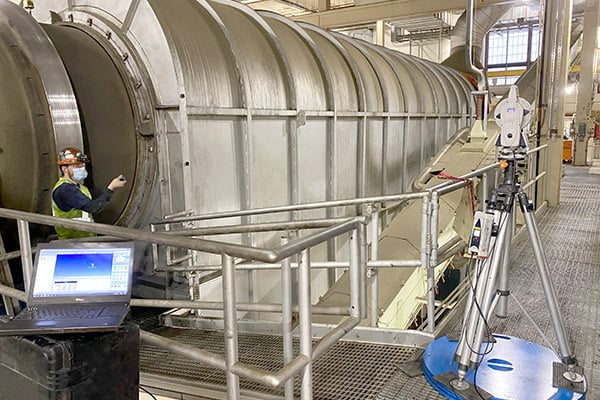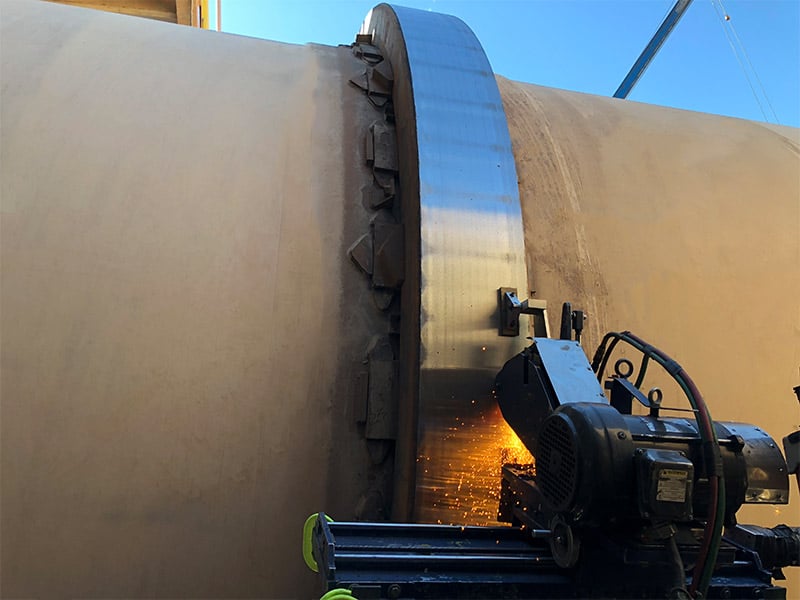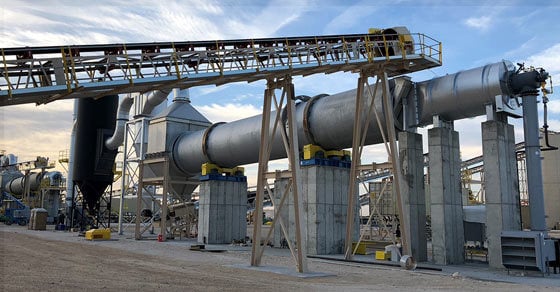When it comes time to carry out rotary drum services, be it on a dryer, cooler, kiln, or granulator, one of the first questions we receive from our customers is: What do you need from us?
The following provides basic guidelines on preparing for a rotary drum service visit. It’s important to note that this is not an exhaustive list; once your rotary drum service is scheduled, FEECO Customer Service Engineers will provide a detailed list of site requirements and materials needed based on your specific service needs.
Planning a Rotary Drum Service Visit
Rotary drums are incredibly reliable, but they do require routine maintenance in order to continue running properly and efficiently. At the same time, unforeseen circumstances may cause damage to the drum, necessitating various types of repairs.
Operators and maintenance personnel should be well versed in inspecting the drum and identifying potential issues at their onset. Plant managers not sure if repairs or maintenance work are needed should consult with a FEECO Customer Service Engineer.
FEECO Customer Service Engineers can conduct an annual inspection or equipment audit to assess the mechanical stability of the drum, troubleshoot any existing issues, and identify any necessary repairs.
Any known issues should be addressed as soon as possible to avoid further damage. Ideally, service work requiring the drum to be shut down will be scheduled so that it coincides with an already-planned shutdown or off-season to avoid additional downtime, but this may not always be possible. FEECO recommends scheduling any anticipated service work as far in advance as possible to avoid scheduling conflicts and, in the case of severe damage, to ensure the work is completed before other damage or a catastrophic failure can occur.
Preparing for Rotary Drum Services
Following the guidelines below, as well as those provided once arrangements have been made, serves as the foundation for a seamless and safe service visit. These guidelines help to ensure that FEECO Customer Service Engineers can stick to the allotted time frame and properly conduct their work without issue. Key factors to consider in preparing for a site visit include:
1. Drum Accessibility
The drum and any components to be repaired must be safely and readily accessible. This might require moving surrounding equipment, ducting, etc., so there is ample space to work on the unit. Any guards, brackets, supports, or safety barriers should also be removed to allow unobstructed access to the unit and its components. If an alignment will be conducted, nearby equipment may require shutdown to prevent vibrations from interfering with the laser alignment system.

A FEECO Customer Service Engineer performs a drum laser alignment
If the drum is elevated on piers, it must be accessible to service engineers via catwalk, manlift, or scaffolding.
If the internals will be inspected and the unit operates at high temperatures, such as with rotary dryers and rotary kilns, the unit should be shut down prior to the visit to allow time for it to cool sufficiently.
2. Lifting Capabilities
Depending on the type of service being conducted, lifting equipment such as hoists, forklifts, or even cranes may be necessary for lifting large replacement components, as well as the tire/trunnion grinding machine (if applicable).
3. Power Supply
Customer Service Engineers use various types of specialized equipment that require an adequate power supply near the drum. Depending on the work being conducted, this typically includes one or both of the following:
- 460-volt, 3-phase, 60-amp power source within 50′ of the drum
- 110-volt, 20-amp power source within 50′ of the drum
Hardware connections must also be available, and in most cases, an electrician will also be required.
For tire and trunnion grinding services, engineers must be able to adjust the speed of the drum, as well as start or stop its rotation, so a VFD may be necessary if the drum is not already equipped with one.

Trunnion wheel grinding in progress
4. Housekeeping & Safety
In addition to being readily accessible, the area surrounding the drum must provide a clean and safe environment in which to work. This includes proper lighting and ventilation.
Fugitive material should be removed so as not to interfere with the work. Trunnion pits, for example, should be cleared of fugitive material; trunnion pits full of material could result in the work going beyond the anticipated timeline.
If laser alignment will be conducted, the removal of fugitive material is necessary, because dust could otherwise interfere with the laser’s ability to track accurately.
5. Tools & Materials
The tools and labor necessary to make bearing adjustments and perform shimming must also be on-hand.
If grinding will be performed, angle iron may be required to serve as a stand for the grinding unit.
A Note on Rotary Drum Parts
FEECO offers an extensive line of replacement rotary drum parts. This not only allows us to supply components as part of our services, but it also lets us work with plant managers and maintenance personnel to establish an on-site inventory of wear-critical parts to minimize future downtime.
Conclusion
FEECO aims to perform all rotary drum services accurately, on time, and on budget. By following the guidelines explained here, plant managers can help to ensure that their site visit goes as smoothly as possible while staying within the allotted time frame and budget.
The FEECO Customer Service Team travels the world inspecting and repairing rotary drums of all kinds. Our Customer Service Engineers bring rotary drum expertise, accurate and timely repair work, and a dedication to exceeding customer expectations to every job site they visit. To schedule an inspection or repairs for your rotary drum, whether it was manufactured by FEECO or a competitor, contact us today!

